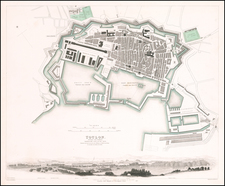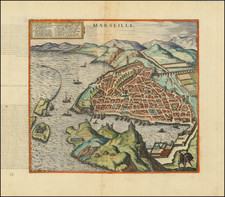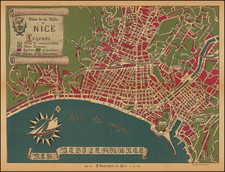Striking Hand-Drawn Plan of Toulon by Louis Marius Eugene Grandjean
Impressive hand-drawn and watercolor plan of Toulon, France, prepared in December 1840 "par Mm Grandjean".
The view illustrates the harbor of Toulon, the town, and its fortified walls in exceptional detail. The details within the harbor and port are quite exactingly rendered and show this beautiful Mediterranean city in exquisite style.
The most evident feature are the pointed bastions that jut out as part of the city’s fortifications. These surround the old town and also encircle the huge docks on the harbor side, the new darse and the old darse. Naval and military buildings are shown in blue, with civilian features in pink.
Within the docks are the dry docks, the mechanical workshop, the prison hospital, and even the Admiral’s ship. As one approaches the town from the docks, one encounters artillery and magazines to the west, all part of the large arsenal there. It is complete with forges, more magazines, a library, and a school. To the east of the docks is the bustling port.
The town itself has important buildings like the cathedral, city hall, barracks, hospital, and theater painted a darker pink and labeled. Parks and open spaces are shown with neat lines of leafy trees.
Toulon is an important military town on the Mediterranean coast. The naval port dates back to 1494, under Charles VIII, and it remains an important military center to this day. Indeed, it still hosts the French aircraft carrier fleet.
In 1660, Louis XIV ordered the famous Sèbastien Le Prestre de Vauban to build a new arsenal and fortifications for the town and port, which provide the layout of the bastions seen here. These new walls were strong enough to withstand a siege by the Sardinians in 1707, but they could not keep out the plague, which killed half the population in a 1720 epidemic.
During the French Revolution, Girondins and royalists seized power back from the Jacobins. The Federalists then surrendered the city and its fleet to the British. The Republican forces, which included Napoleon Bonaparte, placed the city under siege. The British withdrew and the city was punished for its actions. From 1803 to 1805, during the Napoleonic wars, the British were the ones to blockade the port.
In 1820, Toulon was named the base for France’s push into North Africa. Then, only a decade after the completion of this map, the famous architect Georges-Eugene Haussmann redesigned the city with wide boulevards, replacing the twisting Medieval streets seen here.
The map was almost certainly drawn by the French painter Louis Marius Eugene Grandjean, during the time he was employed by the Bureaux des Dessinateurs des Travaux Hydrauliques in Toulon between 1839 and 1841. Louis Grandjean was primarily interested in natural history, and completed a series of works for the Jardin des Plantes in Paris. However, a native of Toulon, he would always hold the city in high esteem and bequeathed the city 800,000 francs upon his death.
Louis Marius Eugène Grandjean was a well-regarded painter and writer, born in Toulon in 1811. Son of Nicolas Grandjean, a senior naval administration officer, Louis Marius Eugène Grandjean studied first at Nîmes. In 1830 he went to Paris where he first studied law and then enrolled at the Faculty of Medicine. As a surgery student, he attended the workshops of the painters Bernard Sénéquier and the Marquis de Clinchamp in Toulon, honing his artistic skills.
Painting became Grandjean's primary occupation and, in 1834, he again left Toulon for Paris, where he entered the Drawing Academy headed by Boudin. After a brief return to Toulon in 1836, he left for Paris in April 1837 in the company of his friend Ch. Ginoux. In order to meet his needs, he produced natural history drawings for Charles-François Brisseau de Mirbel, director of the Museum of the Jardin des Plantes. He also completed some religious paintings.
Between March 1839 and January 1841, Grandjean worked in Toulon as an artist for the Bureaux des Dessinateurs des Travaux Hydrauliques. He returned yet again to Paris in January 1841, where he worked as a designer at the Ministère de la Marine.
After the death of his mother in 1843, he left for Italy in August with his friend Zoppi, visiting Rome, Naples, Florence, Pisa and Livorno. He came back to Paris in September 1845 and retired in 1856. With his inheritance, he lived in Paris and Toulon until his death in 1889.










![(Ceasar's Conquest of Gaul) Description de la Limagne d'Auvergne en forme de dialogue : avec plusieurs medailles, statues, oracles, epitaphes, sentences, & autres choses memorables, & non moins plaisantes que prousitables aux amateurs de l'Antiqué [with map:] Carte de Limagne D'Auvergne](https://storage.googleapis.com/raremaps/img/small/93358.jpg)


![Gallia Narbonens [on sheet with] Savaudiae Ducat. [on sheet with] Venuxini Comitatus Descr.](https://storage.googleapis.com/raremaps/img/small/61471.jpg)
